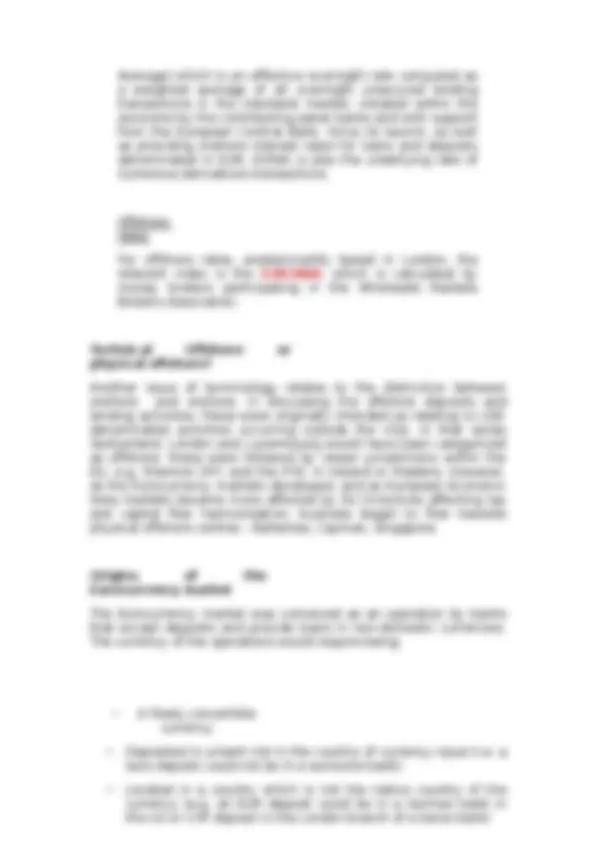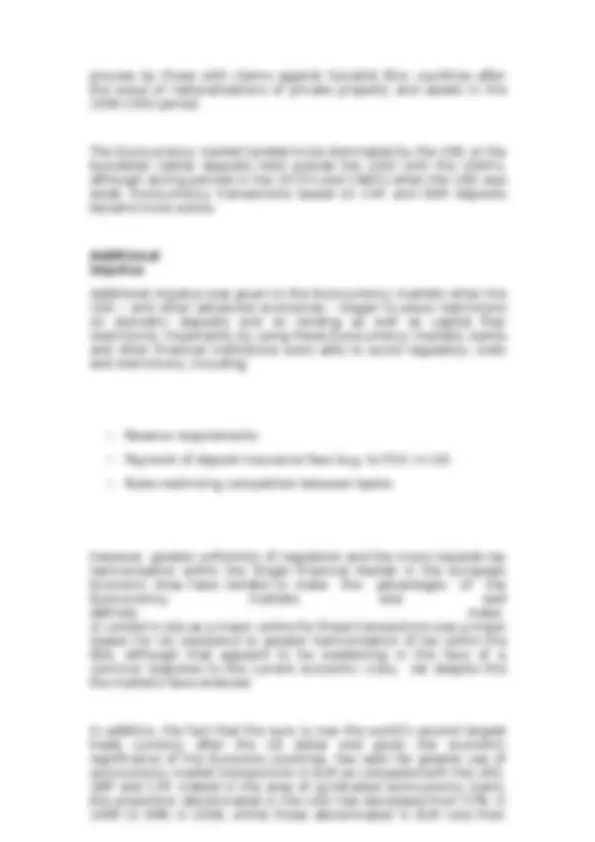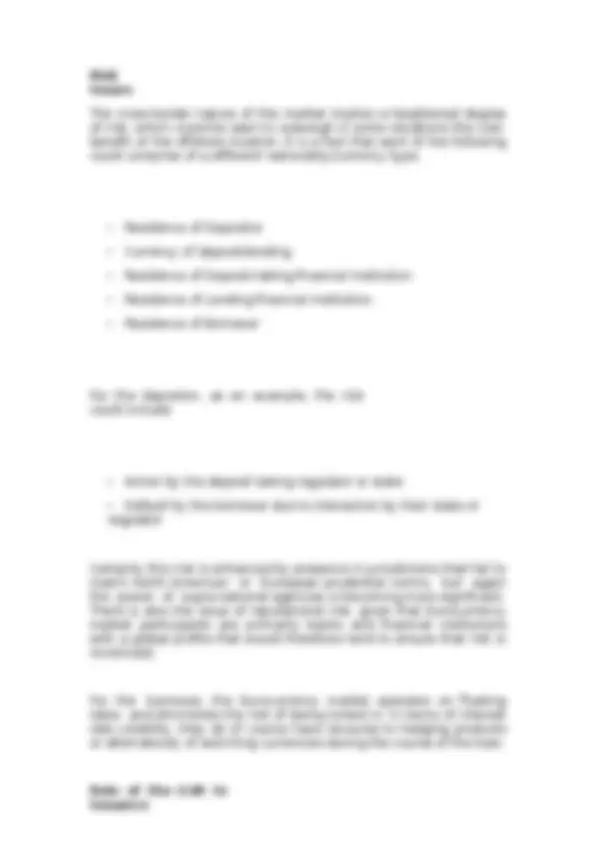








Study with the several resources on Docsity

Earn points by helping other students or get them with a premium plan


Prepare for your exams
Study with the several resources on Docsity

Earn points to download
Earn points by helping other students or get them with a premium plan
Community
Ask the community for help and clear up your study doubts
Discover the best universities in your country according to Docsity users
Free resources
Download our free guides on studying techniques, anxiety management strategies, and thesis advice from Docsity tutors
Detailed informtion about Eurocurrency markets and syndicated loans,Introduction,Definition,“Euro” Terminology,Origins of the Eurocurrency market,Technical Offshore or physical offshore.
Typology: Lecture notes
1 / 12

This page cannot be seen from the preview
Don't miss anything!







Introduct ion
Eurocurrency markets grew initially as a means for offshore financial transactions with minimisation of regulatory and transactional costs. The mode of operation of the markets is also associated with globalised syndication of loans by banking institutions. Whilst the offshore‐onshore differential has been partly eroded by increased costs of offshore activities, the drive for risk‐reduction and tax harmonisation by supra‐national agencies may well eventually see the end of the Eurocurrency markets.
Definiti on?
A market for deposits within a regulatory regime different to that applying to deposits in the country of issue of the currency concerned.
“Euro” Terminology
The use of the terms Euro currency and Eurodollar , for example, were conceived before the actual currency names the euro (EUR) came into existence. However, since 1 January 1999, when the euro replaced the ECU as an official unit of currency, the terminology has become complex for the uninitiated.
Thus prior to 1999, Eurorates implied the Eurocurrency market
interest rates on a range of currencies (USD, GBP, DEM, JPY etc) used in Eurocurrency transactions. However, following the introduction of the euro as the currency of the initial group of 11 countries in the European Monetary Union – i.e. the eurozone – a deposit denominated in EUR would be an onshore deposit in a eurozone bank or financial institution. A deposit denominated in EUR outside the 16 countries now comprising the eurozone (e.g. in London, New York or Stockholm) would be an offshore deposit.
The effect of this on the description of what were previously expressed as Eurorates, the rate of interest applying to Eurocurrency market instruments is now expressed in two formats, dependent on whether onshore or offshore:
Onshore rates
The basic rate is EURIBOR (Euro Interbank Offered Rate), the rate at which EUR‐denominated interbank term deposits are offered by one prime bank to another within the eurozone. It is published at 11h00 (CET) for spot value (T+2) by a panel of eurozone banks operating through the mechanism of the FBE, the federation of European banks. The same panel of banks provides the EONIA (Euro OverNight Index
The market enabled investors to hold short‐term deposits on commercial banks; these banks, through the process of financial intermediation lend those deposits into long‐term streams to corporations and other borrowers.
The use of eurodollars had their origin in the mid‐1950’s in France and the UK; previously banks would simply have remitted USD deposits into the USA money market. However, during the 1950’s there was a strong flow of USD deposits into European financial centres driven by state‐owned or parastatal organisations, foreign trade banks, and import‐export bodies from the USSR and other Council for Mutual Economic Assistance countries. This was due to concerns that if they held USD deposits in US‐domiciled banks, these deposits may be the object of legal
process by those with claims against Socialist Bloc countries after the wave of nationalisations of private property and assets in the 1946 ‐1953 period.
The Eurocurrency market tended to be dominated by the USD or the Eurodollar (dollar deposits held outside the USA) until the 1990’s, although during periods in the 1970’s and 1980’s when the USD was weak, Eurocurrency transactions based on CHF and DEM deposits became more active.
Additional impetus
Additional impetus was given to the Eurocurrency markets when the USA – and other advanced economies – began to place restrictions on domestic deposits and on lending as well as capital flow restrictions. Importantly by using these Eurocurrency markets, banks and other financial institutions were able to avoid regulatory costs and restrictions, including:
However, greater uniformity of regulation and the move towards tax harmonisation within the Single Financial Market in the European Economic Area have tended to make the advantages of the Eurocurrency markets less well defined. Indee d, London’s role as a major centre for these transactions was a major reason for UK resistance to greater harmonisation of tax within the EEA, although that appears to be weakening in the face of a common response to the current economic crisis. Yet despite this the markets have endured.
In addition, the fact that the euro is now the world’s second largest trade currency after the US dollar and given the economic significance of the Eurozone countries, has seen far greater use of eurocurrency market transactions in EUR as compared with the USD, GBP and CHF. Indeed in the area of syndicated eurocurrency loans, the proportion denominated in the USD has decreased from 57% in 1999 to 40% in 2006, whilst those denominated in EUR rose from
be dependent on whether the borrower is a sovereign entity, a non‐ financial corporation or a secondary financial institution.
The margin or spread between the lending bank’s cost of funds and the interest charged by the borrower is based on the borrower’s perceived creditworthiness/ riskiness. The spreads can range from 15 b.p. to more than 300 b.p., the median of the range varying from 100 to 200 b.p. The maturity period would normally range from 3‐ 10 years. Recent data would indicate that fees are now comprising a more significant part of banks earnings from this market than interest rate spreads and furthermore that fee income is not only front‐end loaded, but also occurring through the loan contracts.
Prici ng
The fundamental distinction between onshore/domestic and offshore/non‐resident deposits and loans would appear to be in regard to the higher transactional and regulatory costs incurred onshore. These would include:
In addition, there is the factor that staff, office and payroll costs will be significantly higher in New York or London than in Singapore or Bermuda. The drift of financial markets back office processing business from the USA East Coast to Ireland and then to Eastern Europe or Asia is indicative of the importance of the implicit cost advantage (despite the social disadvantage) in locational dynamics.
Syndicat ion
The majority of Eurocurrency loans are syndicated; this involves a lead bank which having originated the deal will managing the syndicate by bringing in a number of other banks in order to diversify the risk. The borrower will of course be required to pay a fee for the cost of the syndication process, which may range from 0.25% to
2.00% of the loan value. The loan may be drawdown over a period of
time, but will be subject to fees on undrawn balances. A benefit of syndication is that banks economise on the overhead costs of due diligence, structuring and negotiating individual agreements for each borrower and to a degree their negotiating leverage is improved.
It is also possible for the syndicate to provide loans in a specific currency but with a multicurrency clause, which provides the borrower with the option to switch currencies on a specific rollover/ reset date. The option permits the matching of currencies with the borrower’s cash inflows and outflows ‐ thus managing exposure to currency risk. It also allows the borrower to benefit from their own forecasts and estimations of volatilities in FX rates. At the same time the banks in the syndicate can also match their expectations about rates and FX volatility over a relatively shorter period of time.
Given the euro as the currency of more than 300 million citizens and of the largest trading bloc in the world economy, accounting for almost 20% of world export and more than 15% of world GDP, the expanding role of the EUR within the Eurocurrency markets since 1999 is not surprising. It is clear that in general, the share of the single currency in the total issuance of bonds, notes and money market instruments has increased significantly.
Overall, for example, borrowing in EUR denominated instruments from the eurozone money markets alone has almost tripled to just below 25% of worldwide money market activity since 1999. The emergence of deeper markets without currency risks appear to have lowered risk premia and, thus, permanently lowered the borrowing costs in euro. In terms of the amounts outstanding of international debt securities, the growth seen has been able to contribute to expansion of euro‐denominated debt securities stocks. According to the European Commission, the share of euro‐ denominated debt securities in the total amount outstanding of international debt securities – excluding home country issuance – increased during the first three years of the euro at the cost of the other two main currencies, the USD and the JPY.
The development of EU policies affecting Eurocurrency markets
The moves already taken towards harmonisation through the Savings Directive as well as actions closing loopholes on bank secrecy by the Commission have been matched by the actions of other international agencies like OECD and the FATF in removing many of the competitive advantages of offshore centres. This includes both onshore‐offshore centres (e.g. restriction of the Dublin IFSC’s ability to levy 0% investment tax) as well as offshore‐ offshore centres (e.g. pressure on the Netherlands to increase transparency over Antilles jurisdiction).
This has also to be taken into account with the overall package of measures that the
European Council and the Commission have announced in the wake of the 2008‐
2009 financial crisis. This includes:
Reducing counterparty risk
Reducing operational risk
By promoting standardisation of the legal terms of contracts and of contract‐processing
Increasing transparency